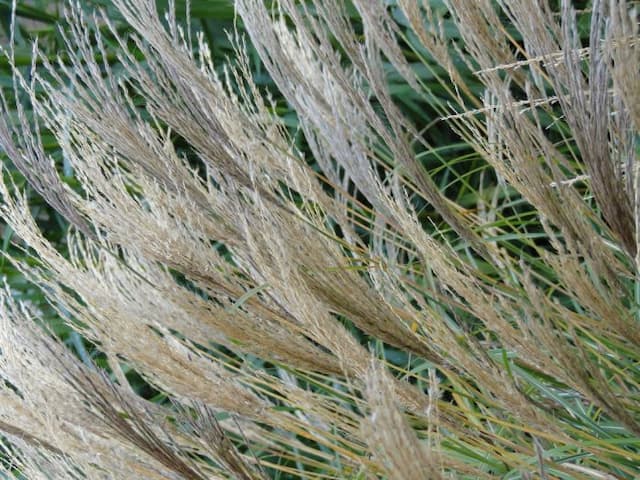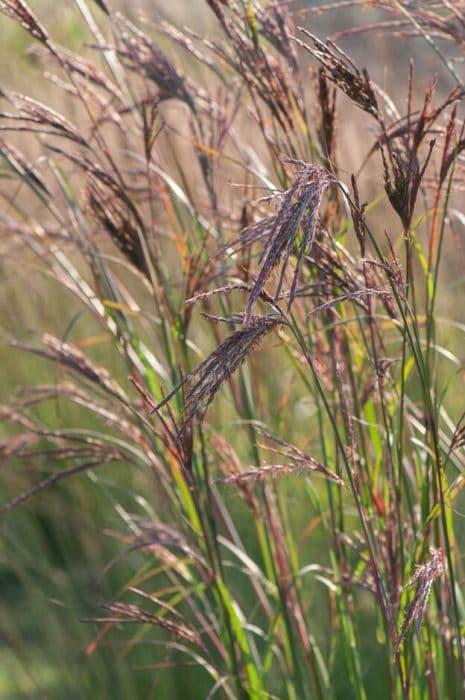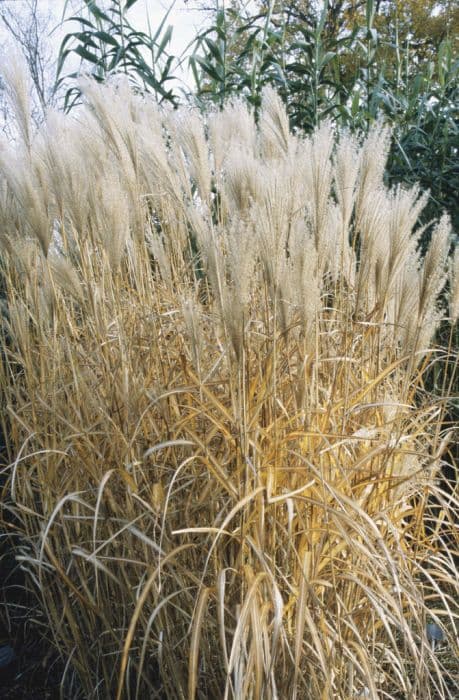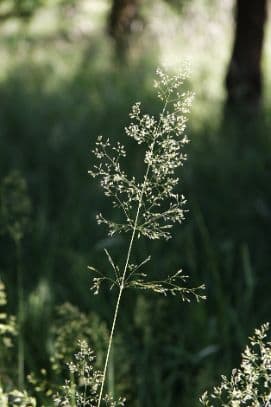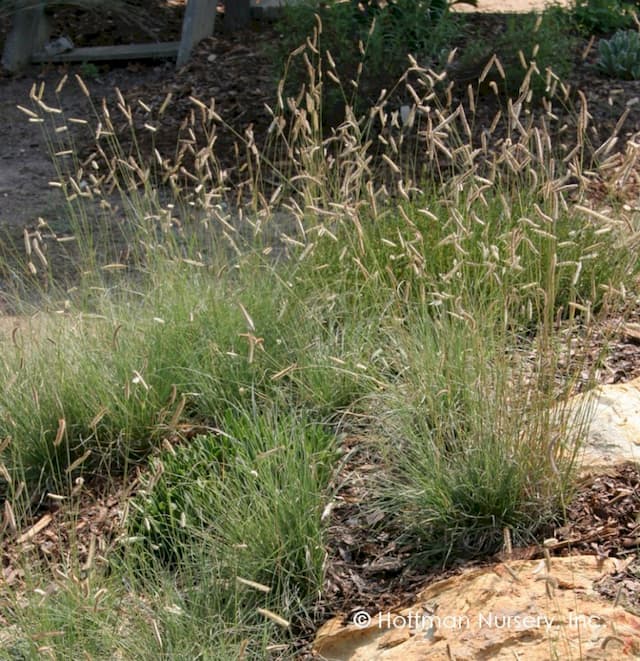Common reed Phragmites australis

ABOUT
The common reed is characteristically a tall and perennial grass with a long, slender, and hollow stem that carries the plant's foliage and flowers. It has an appearance that is reminiscent of a feathery plume due to its large, fluffy flower heads. Each stem typically bears long and flat leaves that are rough to the touch, which can range from green to a bluish-green hue. As the seasons change, so does the color of the common reed. During the growing season, the leaves are vivid green, but as autumn approaches, they start to turn a golden brown, and eventually, during winter, they reach a beige coloration. The flowers, on the other hand, create a soft, purple to pinkish cloud at the top of the stem before maturing to a tan or beige color as they produce seeds. The plant often forms dense stands with its feathery flower heads wavering in the wind, creating a distinctive rustling sound. The roots are creeping rhizomes from which new shoots emerge, enabling the common reed to spread and often create large colonies. These features contribute to the remarkable and easily recognizable aesthetic of the common reed. Overall, the common reed has a strong presence in any landscape, with its imposing flower heads and tall stems that sway with a graceful and rhythmic poise in the breeze.
About this plant
 Names
NamesFamily
Poaceae
Synonyms
Common Reed, Phragmites, European Reed, Giant Reed, Carrizo, Roseau Cane, Steckenreed, Norfolk Reed, Danish Reed, Yellow Cane
Common names
Arundo phragmites, Phragmites communis, Phragmites phragmites, Phragmites vulgaris.
 Toxicity
ToxicityTo humans
Common reed (Phragmites australis) typically is not considered toxic to humans. It does not contain known toxic substances that would cause poisoning if ingested. Therefore, eating parts of the common reed, under normal circumstances, is unlikely to cause adverse health effects in humans. However, as with any plant, it could potentially cause irritation or an allergic reaction in sensitive individuals. It is always advisable to exercise caution and avoid eating plants that are not commonly recognized as food sources without proper expert identification and preparation.
To pets
Common reed (Phragmites australis) is generally not considered toxic to pets either. Just like in humans, this plant is not known to contain substances that are poisonous to pets if they ingest parts of it. Whilst common reed is not a typical food source for pets, accidental ingestion should not lead to serious health issues. Despite its non-toxic status, ingestion of plant material, especially in large quantities, can lead to gastrointestinal discomfort, such as vomiting or diarrhea, due to the physical nature of the plant matter rather than its chemical composition. Pet owners should still monitor their pets and prevent them from consuming non-food plants, as individual animals might react differently.
 Characteristics
CharacteristicsLife cycle
Perennials
Foliage type
Deciduous
Color of leaves
Green
Flower color
Purple
Height
13-20 feet (4-6 meters)
Spread
3-6 feet (1-2 meters)
Plant type
Herb
Hardiness zones
3-9
Native area
Eurasia
Benefits
 General Benefits
General Benefits- Erosion control: Phragmites australis, commonly known as Common reed, has a robust root system that stabilizes soil and can help prevent erosion along riverbanks and in wetland areas.
- Wildlife habitat: It provides a dense habitat for birds, small mammals, and insects, offering protection and nesting sites.
- Water filtration: The extensive root system of the Common reed can trap sediments and absorb nutrients from water, contributing to improved water quality.
- Carbon sequestration: Phragmites australis is efficient in sequestering carbon, thus playing a role in mitigating climate change.
- Biomass production: It grows quickly and produces a large amount of biomass, which can be used for compost or as raw material in the production of biofuels.
- Acoustic insulation: Dense stands of Common reed can reduce noise pollution by acting as sound barriers.
- Wastewater treatment: Phragmites australis can be used in constructed wetlands for wastewater treatment, removing pollutants from effluents.
- Ornamental use: Due to its tall stature and feathery inflorescences, the Common reed can be used in landscaping for ornamental purposes.
- Soil amendment: The decomposition of Common reed biomass adds organic matter to soil, improving its structure and fertility.
- Cultural significance: The Common reed has a long history of use in traditional crafts, such as thatching roofs and weaving mats.
- Livestock fodder: In some regions, it is used as fodder for livestock, especially where other forage options are limited.
- Flood mitigation: The dense stands of Phragmites australis can slow down water flow, potentially reducing the severity of floods.
- Windbreaks: The tall and robust nature of Common reed stands can serve as windbreaks to protect soil and crops from wind damage.
 Medical Properties
Medical Properties- Antipyretic: Phragmites australis has been traditionally used for its fever-reducing properties.
- Diuretic: The plant may possess diuretic effects, promoting the production of urine and supporting kidney health.
- Anti-diabetic: Some studies suggest a potential use in regulating blood sugar levels, implying benefits for diabetes management.
- Antioxidant: Phragmites australis might contain compounds with antioxidant properties, which can help in preventing oxidative stress.
- Antimicrobial: Research indicates that the plant can exhibit antimicrobial activity against certain pathogens.
- Antifungal: There is evidence to suggest antifungal properties, potentially useful against fungal infections.
- Anti-inflammatory: Compounds within the plant can contribute to reducing inflammation, which might be beneficial in treating various inflammatory disorders.
- Hepatoprotective: Some studies on Phragmites australis indicate its potential in protecting the liver from damage.
- Antitussive: Traditionally, it may have been used as a remedy for cough, although there's limited scientific evidence to support this use.
- Gastrointestinal Aid: It may be used to soothe gastrointestinal issues, although further studies are required for these claims.
 Air-purifying Qualities
Air-purifying QualitiesThis plant is not specifically known for air purifying qualities.
 Other Uses
Other Uses- Reedbed Construction: Phragmites australis, commonly known as common reed, is often used to construct reedbeds in wastewater treatment facilities where it helps in the removal of pollutants from the water through microbial activity in its root zone.
- Thatching: The long, sturdy stems of common reed have been used historically for thatching roofs, providing insulation and weatherproofing for buildings.
- Sound Insulation: Dried common reed stalks can be used as a natural sound insulator in walls or between ceiling joists because of their dense, fibrous nature.
- Erosion Control: Its dense growth and extensive root system make common reed an effective plant for stabilizing soil and preventing erosion along riverbanks and coastlines.
- Handicrafts: The stalks of common reed can be woven into mats, baskets, and other crafts, providing a sustainable source of material for artisans.
- Instrument Making: The shafts of common reed have been utilized in the making of musical instruments, such as reed instruments and panflutes, due to their hollow, resonant qualities.
- Windbreaks: Planted in rows, common reed can act as a windbreak to protect crops, reduce soil erosion, and shelter areas from strong winds.
- Wildlife Habitat: Phragmites australis stands provide important habitat for birds, insects, and other wildlife, offering nesting sites and protection.
- Fisheries: Dense stands of common reed can create sheltered areas in coastal environments that serve as nurseries for fish and other aquatic organisms.
- Bioengineering: Common reed can be integrated into bioengineering projects where its growth is used to reinforce soil structure and improve the stability of slopes and stream banks.
Interesting Facts
 Feng Shui
Feng ShuiThe Common Reed is not used in Feng Shui practice.
 Zodiac Sign Compitability
Zodiac Sign CompitabilityThe Common Reed is not used in astrology practice.
 Plant Symbolism
Plant Symbolism- Resilience: Common Reed (Phragmites australis) is known for its hardy nature and ability to thrive in various environments, making it a symbol of adaptability and endurance.
- Flexibility: Due to its tall, flexible stalks that bend without breaking, the plant signifies the ability to withstand challenges without losing strength.
- Invasiveness: In some areas, particularly in North America, Common Reed has become an invasive species, which can symbolize the negative aspects of unchecked growth and domination over native plants.
- Purification: The plant has been used in wetland restoration and water treatment, as it can remove pollutants from water, symbolizing cleansing and purification.
- Transformation: The growth of Common Reed from underwater rhizomes to tall stalks above the surface is seen as a symbol of transformation and emergence.
 Water
WaterThe common reed (Phragmites australis) thrives in wet environments and should be kept consistently moist. It is best to water it deeply, providing around 1-2 gallons per square foot every week, depending on the soil's ability to retain moisture. In standing water or wetland conditions, natural rainfall and surrounding water sources may be sufficient. During dry spells or when establishing new plants, it may be necessary to increase the frequency to ensure the soil around the roots does not dry out.
 Light
LightThe common reed prefers full sunlight but can tolerate partial shade. The best spot for this plant is an area that receives at least six hours of direct sunlight each day. It is adaptable, though, and can grow in areas with less sunlight, which may result in slower growth and less dense stands.
 Temperature
TemperatureThe common reed is resilient and can survive a wide range of temperatures. It can handle temperatures as low as -20 degrees Fahrenheit during dormancy in winter and can grow in temperatures up to 104 degrees Fahrenheit in the summer. For optimal growth, common reeds prefer conditions that are typically found in temperate climates with moderate temperatures.
 Pruning
PruningPruning of the common reed can help control its invasive nature and encourage healthier growth. Cutting back the plant to a few inches above the ground in late winter before new growth starts can be beneficial. Pruning should be done annually, as the plants can grow quite aggressively if left unmanaged. The best time for an extensive cutback is during dormancy in the cold season.
 Cleaning
CleaningAs needed
 Soil
SoilCommon Reed (Phragmites australis) thrives best in wet, loamy soils, but it is highly adaptable to various soil types, provided they are consistently moist. The ideal soil pH for Common Reed ranges from 5.5 to 7.5, favoring neutral to slightly acidic conditions. A mixture of garden soil with plenty of organic matter and some sand for improved drainage would form the best soil mix for this plant.
 Repotting
RepottingCommon Reed (Phragmites australis) is a vigorous grower and may require division and repotting every 1 to 2 years to manage its size and prevent it from becoming pot-bound. In natural settings, this plant is often not repotted as it spreads freely in suitable environments.
 Humidity & Misting
Humidity & MistingCommon Reed (Phragmites australis) is naturally found in wetlands and appreciates high humidity levels. The best humidity conditions for this plant is typically above 60%, which mimics its natural marshy habitat.
 Suitable locations
Suitable locationsIndoor
Bright light, high humidity, frequent watering, keep in large container.
Outdoor
Plant in full sun, marshy or wet soil areas, can spread quickly.
Hardiness zone
4-9 USDA
 Life cycle
Life cycleCommon reed (Phragmites australis) begins its life cycle with seed germination; however, reproduction is typically dominated by vegetative growth through rhizomes. Once a seed germinates, a seedling emerges and, with sufficient nutrients and water, grows into a mature plant capable of photosynthesis. Mature individuals develop tall, stiff stems topped with large, feathery flower plumes by late summer. These flowers produce seeds that are dispersed by wind, water, or animals, although many seeds remain viable in the soil for a short time. Throughout its lifetime, the plant continuously spreads laterally by underground rhizomes, which can give rise to new shoots and create dense stands. The plant goes dormant in the winter, with aerial parts dying back, to resume growth the next spring from the rhizomes.
 Propogation
PropogationPropogation time
Spring to summer
The common reed, Phragmites australis, is typically propagated through division, which is a method where existing plants are divided into smaller parts with individual root systems. This process usually occurs in the late winter or early spring before new growth starts. To propagate the common reed by division, a sharp shovel or spade is used to cut through the dense root systems of a mature clump to separate it into smaller sections. Each section should have at least one growing point or shoot and a portion of the root system. After division, the sections are immediately replanted in moist soil to ensure the roots do not dry out. Proper watering and site conditions conducive to the species will help ensure successful establishment of new reed plants.

